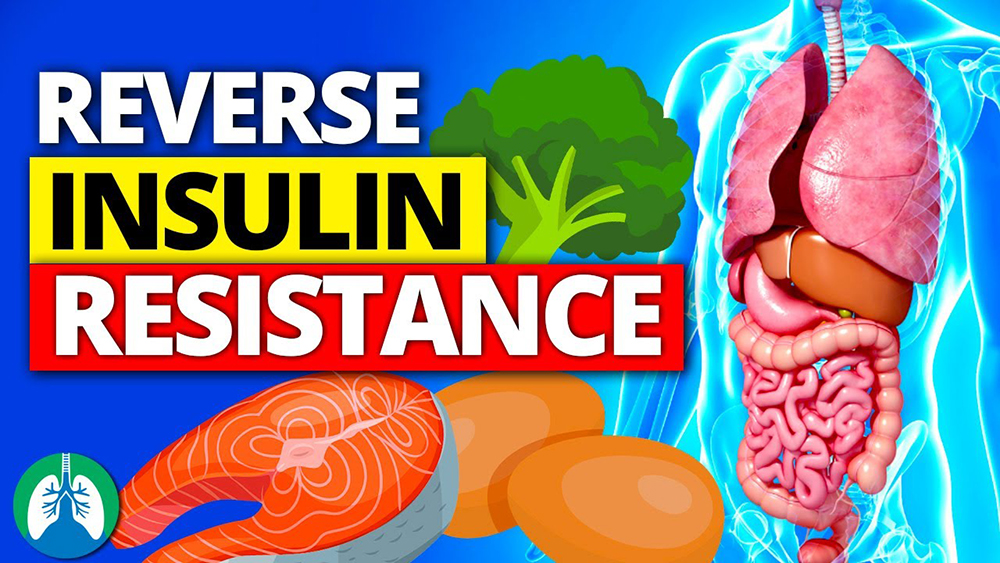How to Reverse Insulin Resistance

How to Reverse Insulin Resistance
According to the Centers for Disease Control (CDC), more than 100 million United States adults are living with diabetes or prediabetes [1]. Further, the CDC also estimated that 80 million Americans are insulin-resistant, which is a precursor to diabetes [2].
Insulin is one of the body’s most important hormones. Insulin plays a blood sugar-modulating role by telling cells to open up and take glucose [sugar] from the blood. However, with insulin resistance, cells begin to be desensitized to insulin, which requires more and more insulin to be released for the same effect. Thus, insulin levels perpetually rise. Further, since cells cannot absorb glucose in the blood, blood glucose levels continue to increase.
Although insulin is a naturally occurring hormone, insulin resistance has been linked to a wide range of health consequences, including cancers of the bladder, breast, colon, cervix, pancreas, prostate, and uterus, cardiovascular disease, and fatty liver disease [2] [3] [4].
Sadly, many people can be insulin-resistant and never know, so it is crucial to speak with a doctor to make sure your insulin and blood sugar levels are within a healthy range.
In this article, we will review eight natural compounds that can help restore and maintain the cells’ sensitivity to insulin.
Turmeric
Curcumin, which is an active compound in turmeric, has been shown to help activate glucose uptake in the cells.
In a 2009 study, researchers investigated the glucose uptake-supporting effects of curcumin and noted it was 500 to 100,000 times more effective than the pharmaceutical Metformin at activating glucose uptake [6].
In a 2012 randomized, double-blind, placebo-controlled study, researchers investigated the effects of curcumin in people with prediabetes [7]. The researchers split 240 prediabetic patients into two groups: a curcumin group and a placebo group. The researchers gave individuals in the curcumin group 250 mg of curcumin a day, and the placebo group received a placebo.
After nine months, the researchers evaluated the patients, and none of the patients in the curcumin group had developed diabetes, whereas 16.4% of patients in the control group had [7].
Further, the researchers noted, “The curcumin treatment appeared to improve the overall function of beta-cells, with very minor adverse effects. Therefore, this study demonstrated that the curcumin intervention in a prediabetic population may be beneficial” [7].
Therefore, not only did curcumin prevent 100% of the patients in the curcumin group from developing diabetes, but curcumin also increased the activity of beta-cells, which promote and secrete insulin.
Healthmasters offers a turmeric product called Turmeric Force.
Ginger
Ginger has regularly been investigated for its anti-insulin-resistance properties.
In a 2014 randomized, double-blind, placebo-controlled trial, researchers investigated the effect of ginger supplementation on insulin-resistance and glycemic indices in people with type-2 diabetes [8]. Researchers randomly assigned eighty-eight participants to a ginger group or a placebo group. Participants in the ginger group were given three one-gram ginger capsules a day, and people in the placebo group were given a placebo capsule. The study lasted for eight weeks [8].
At the end of the study, the average fasting blood sugar measurement in the ginger group decreased by 10.5%, whereas the average in the placebo group increased by 21%. Insulin sensitivity also rose significantly in the ginger group [8].
The researchers concluded, “The study demonstrated that daily consumption of 3 one-gram capsules of ginger powder for 8 weeks is useful for patients with type 2 diabetes due to FBS and HbA1c reduction and improvement of insulin resistance indices such as QUICKI index” [8].
In another 2014 study, researchers conducted a similar experiment but with 1.6 grams of ginger a day [9]. The researchers found ginger supplementation improved eight markers of diabetes, including insulin sensitivity.
The authors concluded, “Ginger improved insulin sensitivity and some fractions of lipid profile, and reduced CRP and PGE₂ in type 2 diabetic patients. Therefore, ginger can be considered as an effective treatment for the prevention of diabetes complications” [9].
Cinnamon
Perhaps one of the most well-researched compounds regarding blood sugar health, cinnamon has been shown to decrease insulin resistance.
In a 2011 meta-analysis of eight studies, researchers noted, “cinnamon extract and/or cinnamon improves FBG in people with type 2 diabetes or prediabetes” [10].
Cinnamon does this by slowing the rate at which the stomach empties after eating.
In a 2007 study, researchers compared the gastric emptying rate (GER) of individuals who ate rice pudding with and without cinnamon [11]. By adding the cinnamon, the rate the stomach emptied decreased from 37% to 35.4%, which significantly slowed the increase in blood sugar levels. Therefore, even less than half a teaspoon can reduce blood sugar levels in type-2 diabetics [11].
Healthmasters offers a cinnamon-containing product called Healthmasters’ Cinnamon Extract Fuel Burner.
Olive Leaf Extract
Researchers at the University of Auckland, New Zealand, investigated the effects of olive leaf extract would have on blood sugar levels.
In a 2013 randomized, placebo-controlled, crossover trial, researchers assessed the effects of supplementation with olive leaf polyphenols on insulin resistance and cardiovascular risk factors in middle-aged, overweight men [12].
The forty-six participants were randomly selected to receive either a capsule with olive leaf extract or a placebo for twelve weeks. After the study, the olive leaf extract lowered insulin resistance by a mean of 15% and increased the productivity of beta-cells by 28%
The scientists concluded, “Supplementation with olive leaf polyphenols for 12 weeks significantly improved insulin sensitivity and pancreatic beta-cell secretory capacity in overweight, middle-aged men at risk of developing metabolic syndrome” [12].
Berries
Although it may seem strange, researchers have noted the insulin-modulating effects of berries because their polyphenols reduce the digestion and absorption of starch and thereby suppress after-meal glycemia.
In a 2013 study, researchers had participants consume either white wheat bread or rye bread, with or without 150 grams of berries [13]. The researchers found that eating berries with bread significantly reduced the after-meal insulin spike. Strawberries, bilberries, lingonberries, and chokeberries were effective individually, and a mixture of strawberries, bilberries, cranberries, and blackberries was also effective [13].
Black Seed (Nigella Sativa)
The black seed seems to have innumerable benefits, including its ability to support blood sugar levels.
In a 2010 study, researchers gave ninety-four participants either one, two, or three grams of Nigella sativa capsules for three months [14]. The researchers noted, “Nigella sativa at a dose of 2 gm/day caused significant reductions in FBG, 2hPG, and HbA1 without significant change in body weight” [14]. Fasting glucose and HbA1C levels decreased an average of 56 mg/dl and 1.52%, respectively, by the end of the three-month study.
The researchers concluded, “The results of this study indicate that a dose of 2 gm/ day of Nigella sativa might be a beneficial adjuvant to oral hypoglycemic agents in type 2 diabetic patients” [14].
Healthmasters offers a Black Seed Oil product.
Spirulina
Spirulina is a type of organism that grows in fresh and saltwater, and it’s a type of blue-green algae.
In a 2011 randomized pilot study, researchers investigated the effects of spirulina versus soybean on insulin resistance in HIV-infected patients [15]. The researchers assigned seventeen patients to receive 19 grams of spirulina a day, and the remaining 16 patients received 16 grams of soy. After eight weeks, participants in the spirulina group had an average increase in insulin sensitivity of 224.7%, while the soy group’s increased by 60% [15].
Further, 100% of participants in the spirulina group had increased insulin sensitivity parameters, whereas only 69% of the participants in the soy group had improved insulin sensitivity [15].
Berberine
Berberine is a natural compound found in several plants, such as goldenseal, goldthread, and Oregon grape. Several studies have shown that berberine is just as effective as pharmaceutical diabetes drugs.
In a 2008 study, berberine was compared to metformin and found berberine lower blood sugar levels just as well as metformin in three months, along with the patients' fasting blood glucose and after-meal blood glucose [16].
In the same study, researchers gave berberine to people with diabetes for three months, and after one week, berberine lowered fasting and post-meal blood glucose levels. The researchers also noted an average insulin resistance decrease of 45% [16].
In a 2012 meta-analysis, researchers evaluated fourteen randomized trials that included 1,068 participants [17]. Each of the studies investigated berberine’s effect in the treatment of type 2 diabetes. The researchers noted, “Berberine appeared to be efficacious for treating hyperglycemia and dyslipidemia in T2DM [type-2 diabetes]” [17].
The researchers also found that berberine performed similarly to metformin, glipizide, and rosiglitazone, which are the top three diabetic drugs on the market, without any severe side effects.
Healthmasters offers Berberine Ultimate.
Conclusion
In this article, we reviewed eight compounds that have been shown to reverse insulin resistance. These compounds include turmeric, black seed, cinnamon, ginger, and berberine. These compounds are completely natural and do not have many of the associated side effects that come with pharmaceutical medication.
If you are interested in trying some of these products, speak to your doctor.
If you have questions about any of the products mentioned in this article, please feel free to call our office at 800.726.1834.
References:
[1] https://www.cdc.gov/media/releases/2017/p0718-diabetes-report.html
[2] https://insulinnation.com/treatment/medicine-drugs/know-insulin-resistance/
[3] https://www.ncbi.nlm.nih.gov/pubmed/23271574
[4] https://www.ncbi.nlm.nih.gov/pubmed/23207292
[5] https://www.ncbi.nlm.nih.gov/pubmed/23725242
[6] https://www.ncbi.nlm.nih.gov/pubmed/19665995
[7] https://www.ncbi.nlm.nih.gov/pubmed/22773702
[8] https://www.ncbi.nlm.nih.gov/pubmed/24559810
[9] https://www.ncbi.nlm.nih.gov/pubmed/24490949
[10] https://www.ncbi.nlm.nih.gov/pubmed/21480806
[11] https://www.ncbi.nlm.nih.gov/pubmed/17556692
[12] https://www.ncbi.nlm.nih.gov/pubmed/23516412
[13] https://www.ncbi.nlm.nih.gov/pubmed/23365108
[14] https://www.ncbi.nlm.nih.gov/pubmed/21675032
[15] https://www.ncbi.nlm.nih.gov/pubmed/22254118

